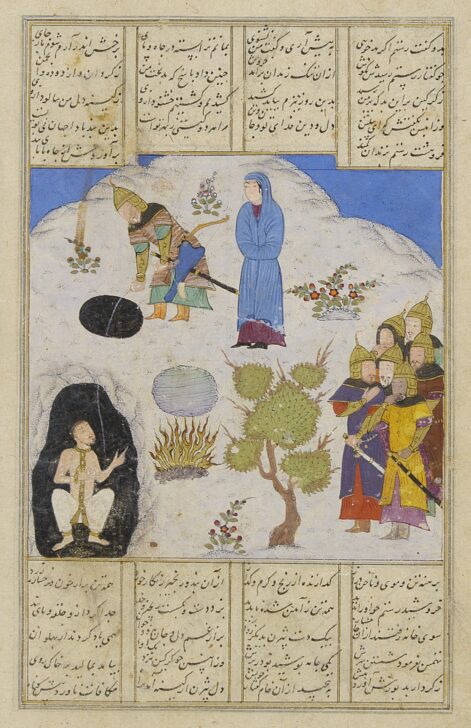Rustam Takes Bijan out of the Pit, from the Shahnama of Firdausi
Iranian

Description
Bizhan is the son of Giv (who appears in 1963/1.50), and thus a member of one of the most illustrious clans of warriors in the service of the Shah Kai Khusrau. He tended to be both over-confident and impatient, however, which frequently led him into trouble. One day when hunting boar in enemy territory, Bizhan came across the camp of Manizha, a daughter of Afrasiyab, King of Turan. They instantly fell in love, and Manizha drugged Bizhan to take him back to her own quarters in the palace. When Afrasiyab discovered the lovers, he had Bizhan bound in irons and cast into a pit, and disinherited Manizha. Naturally, Bizhan’s rescue fell to Rustam, who was his maternal grandfather. Rustam came to the city of the Turanians in disguise, where he found Manizha and told her of his plans.
Manizha, joyful at the words and freed
From trouble, hastened to the mountain-top,
Where in the pit her lover was confined, …
Manizha went and set a-blaze a fire,
That scorched the eye of the pitch-black night. …
Then matchless Rustam led them toward the fire.
When he …
Approached that pit of sorrow, smart, and anguish, …
The lion-chief alighted, hitched his skirt
Of mail beneath his belt and, asking strength
From God its source, grasped, raised, and hurled the boulder
Back to the forest of the land of Chin. …
Then Rustam let his lasso down the pit,
And drew up thus Bizhan with fettered feet,
With naked body, with long hair and nails,
And wasted by affliction, pain, and want. …
Warner, III, 342–46
Since the perspective on human, animal, and floral forms in early Persian painting was usually horizontal, the need to portray Bizhan in a deep pit presented a challenge to the painter when composing the scene. His solution was to create two “stories,” one above ground and one below, to which we viewers have special access.
———
Maribeth Graybill, Senior Curator of Asian Art
Exhibited in "A Medieval Masterpiece from Baghdad: the Ann Arbor Shahnama"
August 14 through December 19, 2004
Subject Matter:
Manizha, joyful at the words and freed
From trouble, hastened to the mountain-top,
Where in the pit her lover was confined, …
Manizha went and set a-blaze a fire,
That scorched the eye of the pitch-black night. …
Then matchless Rustam led them toward the fire.
When he …
Approached that pit of sorrow, smart, and anguish, …
The lion-chief alighted, hitched his skirt
Of mail beneath his belt and, asking strength
From God its source, grasped, raised, and hurled the boulder
Back to the forest of the land of Chin. …
Then Rustam let his lasso down the pit,
And drew up thus Bizhan with fettered feet,
With naked body, with long hair and nails,
And wasted by affliction, pain, and want.…
Physical Description:
This Persian miniature is attributed to the Shiraz and Timurid schools, ca. 1460. The painting is done in ink, opaque watercolor and gold leaf on paper. The scene, Rustam Takes Bijan out of the Pit, is part of the Shahnama of Firdausi, the Persian book of kings.
Usage Rights:
If you are interested in using an image for a publication, please visit https://umma.umich.edu/request-image/ for more information and to fill out the online Image Rights and Reproductions Request Form.